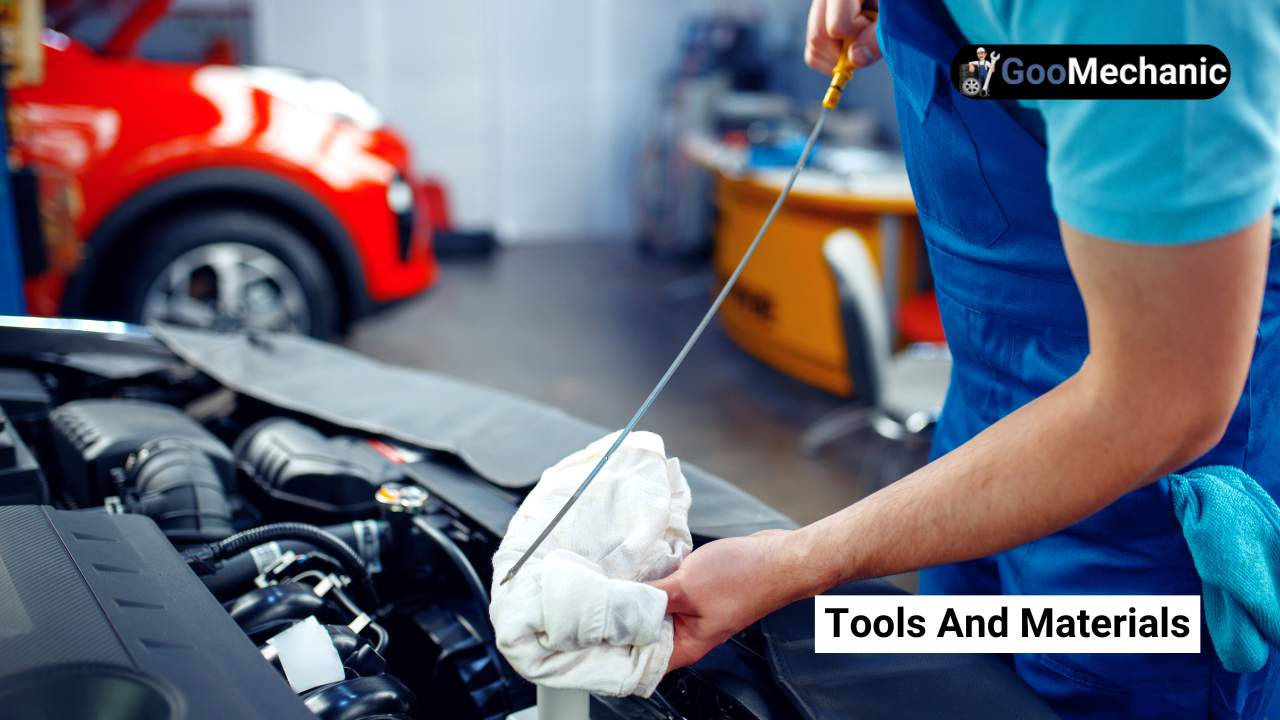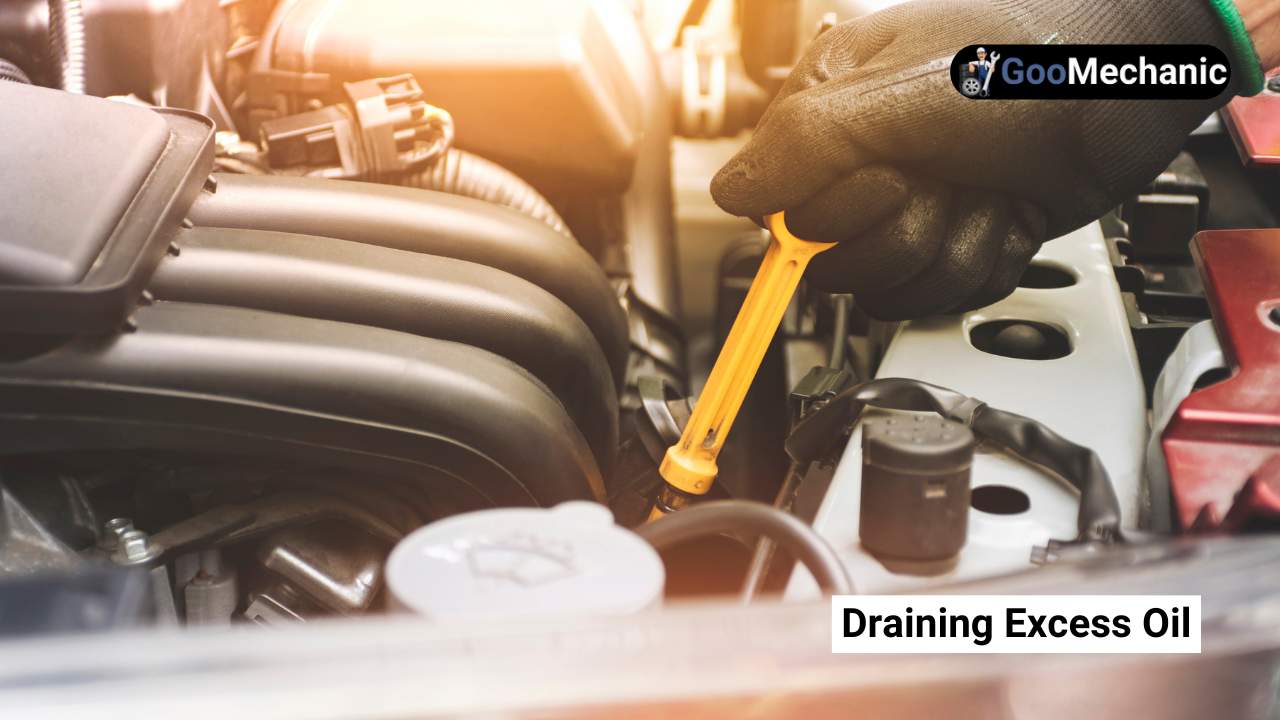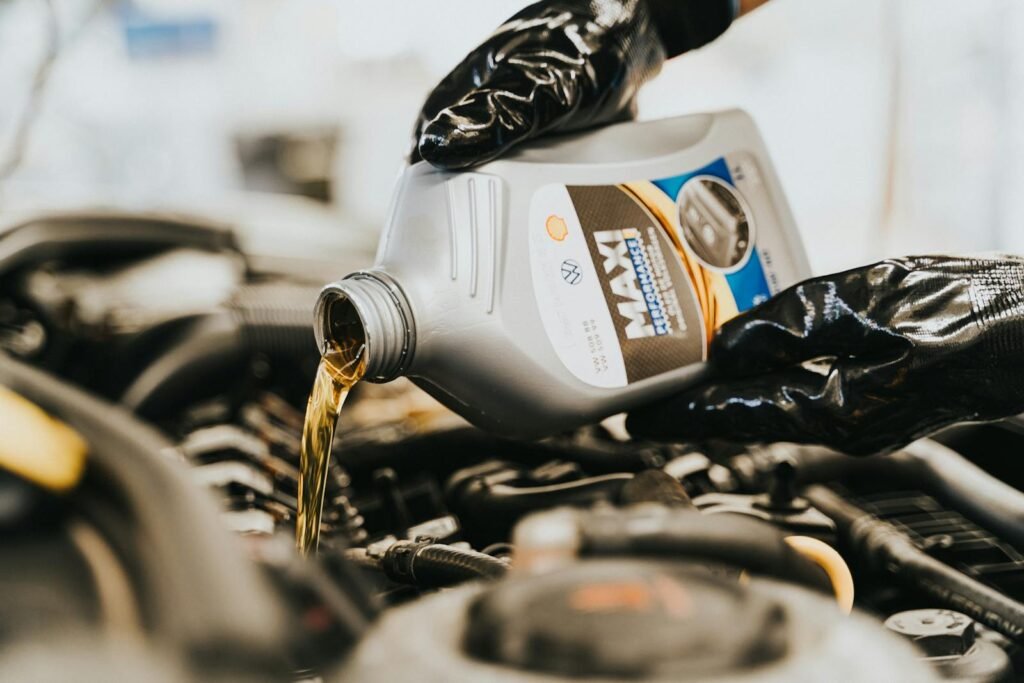To remove excess oil from the engine, use an oil extractor or drain the oil pan. Ensure the engine is cool before starting.
Excess oil in an engine can cause significant problems. It may lead to increased pressure and potential seal damage. Removing excess oil ensures the engine operates efficiently and reduces the risk of leaks. Begin by locating the oil drain plug underneath the vehicle.
Place a container to catch the excess oil. Carefully unscrew the plug and let the oil drain until it reaches the proper level. Alternatively, use an oil extractor for a cleaner process. Regular maintenance and correct oil levels keep your engine healthy and extend its lifespan. Always check your vehicle’s manual for specific guidelines and recommended oil levels.
Tools And Materials

Removing excess oil from your engine is a crucial task. Using the right tools and materials makes the job easier and safer. Here’s a breakdown of what you need.
Essential Tools
The right tools ensure you can remove excess oil effectively. Here are the essential tools:
- Oil Drain Pan: Catches the excess oil.
- Wrench Set: Loosens the drain plug.
- Oil Filter Wrench: Removes the oil filter.
- Funnel: Helps pour oil without spilling.
- Gloves: Protects your hands from oil.
- Jack and Jack Stands: Lifts the car safely.
Required Materials
Besides tools, you need specific materials for the task. Below is a list of necessary materials:
- New Oil: Replace the old oil.
- Oil Filter: Replace the old filter.
- Oil Disposal Container: Stores used oil for proper disposal.
- Rags: Cleans up any spills.
Having these tools and materials ready ensures a smooth and efficient oil removal process. Each item plays a vital role in the task.
Preparation Steps

Removing excess oil from your engine requires careful preparation. Proper preparation ensures safety and efficiency. Follow these steps to get started.
Safety Precautions
Prioritize safety during this process. Always wear safety gear. This includes gloves and safety goggles. Ensure the engine is cool before starting. A hot engine can cause burns. Keep a fire extinguisher nearby. This is a precaution against unexpected fires.
Work Area Setup
Set up your work area properly. A clean, organized space is essential. Use a flat, stable surface for your tools.
| Tool | Purpose |
|---|---|
| Oil Pan | To catch the excess oil |
| Wrenches | For loosening bolts |
| Rags | To clean spills |
Ensure the area is well-lit. Good lighting helps you see clearly. Keep children and pets away from the work area.
- Gather all necessary tools.
- Place the oil pan under the engine.
- Position your wrenches within reach.
With these steps, your workspace is ready. Proceed with confidence to remove excess oil.
Locating The Oil Drain Plug
Removing excess oil from your engine is crucial for its health. The first step is to locate the oil drain plug. This small task ensures your engine runs smoothly. Below, we explain how to find this essential component.
Vehicle Manual Reference
Your vehicle manual is your best friend here. It contains vital information about your car. Open the manual and go to the section about engine oil. You will find details on the oil drain plug location. The manual often includes diagrams for easy reference.
| Manual Section | Information Provided |
|---|---|
| Engine Overview | General engine layout |
| Maintenance Schedule | Oil change intervals |
| Oil Drain Plug | Exact location and diagram |
Identifying The Plug
Once you’ve consulted the manual, it’s time to identify the plug. The oil drain plug is usually located at the bottom of the oil pan. It is a bolt or a screw with a washer. Here’s a step-by-step guide to identify it:
- Jack up the car safely.
- Look for the oil pan beneath the engine.
- Locate the bolt or screw at the lowest point.
- Confirm it matches the manual’s description.
Important: Ensure the car is off and cool before starting. Always use safety gear. This includes gloves and safety glasses. The oil can be very hot. Handle with care.
Tip: Place an oil catch pan under the plug before removing it. This helps collect the drained oil without making a mess.
Draining Excess Oil

Draining excess oil from your engine is crucial. Too much oil can cause engine damage. Follow these steps to safely remove the extra oil.
Positioning The Drain Pan
First, place the drain pan under the oil drain plug. Ensure it is centered to catch all the oil. This prevents spills and keeps your workspace clean.
Loosening The Plug
Next, use a wrench to loosen the oil drain plug. Turn it counterclockwise. Be careful as the oil may be hot. Allow the excess oil to drain into the pan.
Once the oil stops flowing, tighten the plug back. Check the oil level with the dipstick. Ensure it is within the recommended range.
| Step | Description |
|---|---|
| Position Drain Pan | Place it under the oil drain plug |
| Loosen Plug | Use a wrench to turn counterclockwise |
| Drain Oil | Let the excess oil flow into the pan |
| Tighten Plug | Secure the plug back in place |
| Check Oil Level | Use the dipstick to ensure proper level |
Important: Always dispose of used oil properly. Take it to a recycling center.
Measuring The Oil Level
Maintaining the correct oil level in your engine is crucial. Too much oil can cause damage. Measuring the oil level is a simple task. It helps keep your engine running smoothly.
Using The Dipstick
To measure the oil level, you will need a dipstick. The dipstick is usually located near the engine. Here is how to use it:
- Ensure the engine is off and cool.
- Locate the dipstick and pull it out.
- Wipe it clean with a cloth.
- Reinsert the dipstick fully.
- Pull it out again to check the oil level.
Reading Oil Levels
Reading the oil levels on the dipstick is easy. Follow these steps:
- Hold the dipstick horizontally.
- Look at the oil on the dipstick.
- Check the markings on the dipstick.
The dipstick has markings for minimum and maximum oil levels. The oil should be between these marks. If the oil is above the maximum mark, you have too much oil. If it is below the minimum mark, you need to add oil.
Regularly checking your oil level can prevent engine problems. It is a quick and simple task. Always keep your engine’s oil level in check.
Refilling With Correct Amount
Refilling your engine with the correct amount of oil is crucial. Too much or too little oil can harm your engine. Follow these steps to ensure your engine runs smoothly.
Choosing The Right Oil
Selecting the right type of oil is the first step. Refer to your car’s manual for the recommended oil type. You can also check the oil cap for guidance.
Here are some common types of engine oils:
- Conventional Oil – Suitable for older engines.
- Synthetic Oil – Good for high-performance engines.
- High-Mileage Oil – Best for engines over 75,000 miles.
Choose the oil that matches your engine’s needs.
Pouring The Oil
Make sure your car is on a level surface. Open the oil cap and insert a funnel. This helps to pour oil without spilling.
Pour the oil slowly and steadily. Use the dipstick to check the oil level. Add more oil if needed, but avoid overfilling.
Follow these steps to ensure you pour the right amount:
- Insert the Funnel – Place it securely in the oil fill hole.
- Pour the Oil – Slowly pour the oil into the funnel.
- Check the Level – Use the dipstick to check the oil level.
- Adjust if Needed – Add or remove oil to reach the correct level.
Once you have the correct amount, close the oil cap tightly. Dispose of any used oil responsibly.
Disposing Of Used Oil
Proper disposal of used engine oil is very important. It protects the environment and follows legal guidelines. This section will guide you on how to dispose of used oil safely.
Environmental Guidelines
Used engine oil is harmful to the environment. It contains toxic substances that can pollute water and soil. Follow these environmental guidelines to dispose of used oil correctly:
- Never pour used oil down the drain. It can contaminate water sources.
- Store used oil in a clean container. Make sure the container is leak-proof.
- Label the container clearly. This helps in identifying the contents.
- Avoid mixing used oil with other substances. Mixed oil is harder to recycle.
Local Disposal Facilities
Local disposal facilities are the best places to take used oil. They ensure the oil is handled safely. Find a facility near you:
| Facility Name | Address | Contact Number |
|---|---|---|
| Eco Oil Disposal Center | 123 Green Street | (123) 456-7890 |
| Safe Waste Services | 456 Eco Lane | (987) 654-3210 |
| Green Earth Facility | 789 Clean Avenue | (555) 123-4567 |
Call the facility before visiting. Confirm their hours of operation and any specific guidelines they may have.
Recycling used oil is better than disposing of it. Many facilities offer recycling services. This helps in conserving natural resources and reducing pollution.
Remember, proper disposal of used oil is a shared responsibility. It ensures a cleaner and safer environment for everyone.
Final Checks
Final checks are crucial after removing excess oil from your engine. Ensuring everything is in place prevents future issues. These steps help confirm your work is effective and safe.
Inspecting For Leaks
Check under the car for oil leaks. Look for fresh oil spots on the ground. If you see any, your engine might still be leaking.
Next, inspect around the oil filter and oil drain plug. Use a flashlight to see clearly. If you notice oil around these areas, you may need to tighten them.
Use a clean cloth to wipe around the engine. This helps find any oil dripping. Be thorough and ensure no area is missed.
Test Driving
Start your car and let it run for a few minutes. Pay attention to any unusual noises. If you hear strange sounds, turn off the engine immediately.
Take your car for a short drive. Keep it under 20 minutes. This helps circulate the oil and identify any leaks.
After the drive, park on a clean surface. Check for new oil spots. If you see none, your engine is likely in good shape.
Lastly, monitor the oil level for the next few days. Use the dipstick to check. This ensures your oil level stays correct.
| Step | Action |
|---|---|
| Check for leaks | Inspect under the car and around the engine |
| Test drive | Drive for 20 minutes and check for new spots |
| Monitor oil level | Use the dipstick daily for a few days |
Frequently Asked Questions
What Is The Easiest Way To Remove Excess Engine Oil?
Use an oil extractor pump to remove excess engine oil. Insert the tube into the dipstick hole and pump.
What To Do If You Overfill Your Oil?
Drain the excess oil immediately using the oil drain plug. Check the oil level with the dipstick. Refill if needed. Dispose of the excess oil properly. Regularly monitor oil levels to prevent future overfilling.
Can I Siphon Excess Oil Out Of My Car?
Yes, you can siphon excess oil from your car. Use a siphon pump to remove the oil safely. Ensure you check the oil level afterward.
How To Take Out Oil From An Engine?
To remove oil from an engine, first, warm it up. Place a drain pan under the oil plug. Remove the plug and let the oil drain completely. Replace the plug and refill with new oil. Dispose of the old oil properly.
Conclusion
Regularly removing excess oil from your engine ensures optimal performance and longevity. Following these simple steps will help maintain your vehicle. Always use the right tools and techniques for safety. Keeping your engine clean not only improves efficiency but also prevents costly repairs.
Stay proactive in engine maintenance for a smoother ride.
Read More: Can I Put Oil in My Car When It’s Hot

